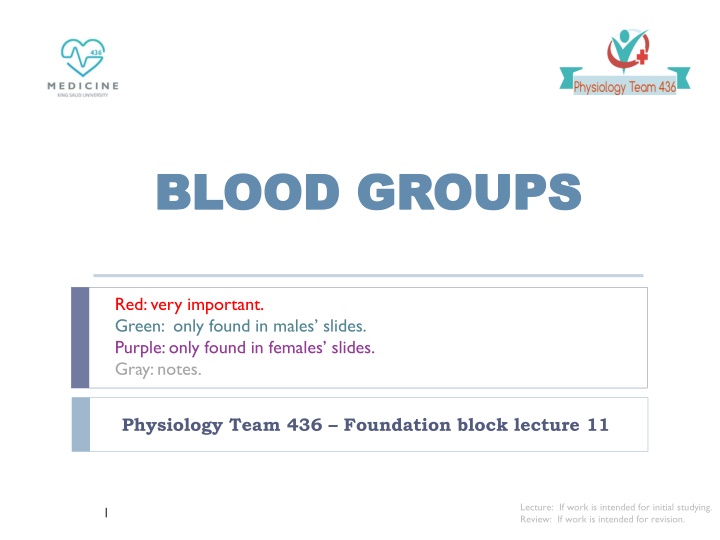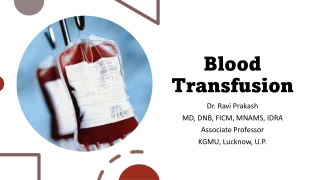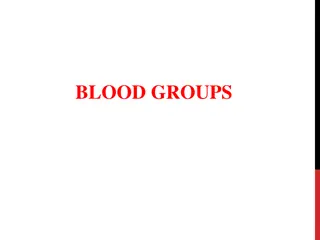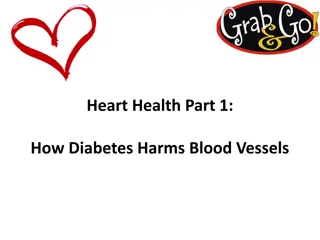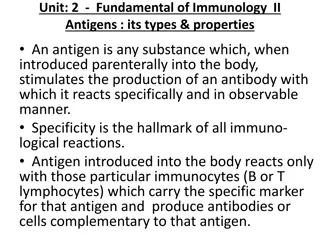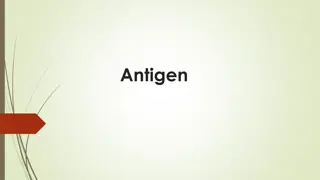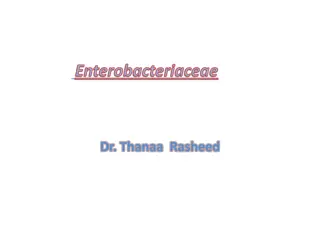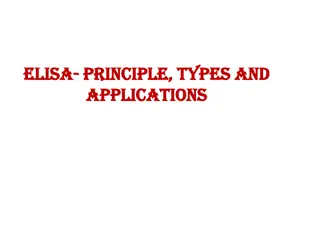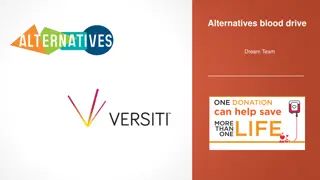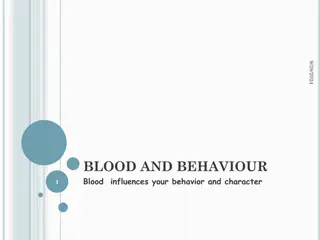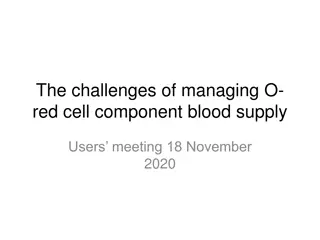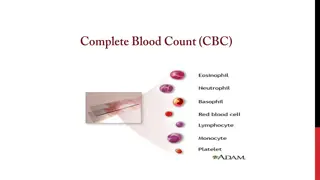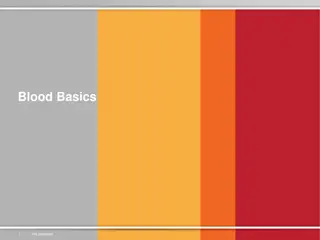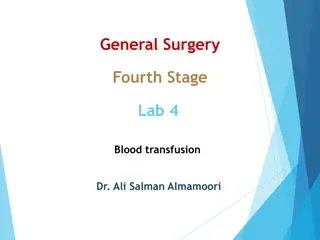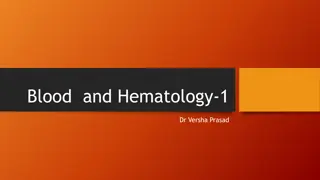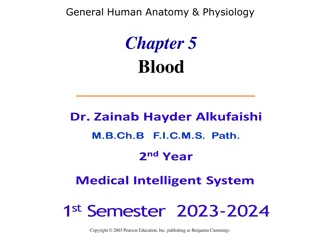Blood Groups and Antigens: A Comprehensive Overview
Blood groups are determined by antigens on the surface of red blood cells. Understanding ABO and Rh blood group systems, genetic inheritance, transfusion reactions, and more. Explore the significance of agglutinogens and agglutinins in blood transfusions. Learn about the discoveries by Karl Landsteiner and the relationship between antigens and antibodies.
Download Presentation

Please find below an Image/Link to download the presentation.
The content on the website is provided AS IS for your information and personal use only. It may not be sold, licensed, or shared on other websites without obtaining consent from the author.If you encounter any issues during the download, it is possible that the publisher has removed the file from their server.
You are allowed to download the files provided on this website for personal or commercial use, subject to the condition that they are used lawfully. All files are the property of their respective owners.
The content on the website is provided AS IS for your information and personal use only. It may not be sold, licensed, or shared on other websites without obtaining consent from the author.
E N D
Presentation Transcript
BLOOD GROUPS BLOOD GROUPS Red: very important. Green: only found in males slides. Purple: only found in females slides. Gray: notes. Physiology Team 436 Foundation block lecture 11 Lecture: If work is intended for initial studying. Review: If work is intended for revision. 1
Objectives Describe ABO blood groups types. Recognize Agglutinin in plasma. Describe genetic inheritance of Blood groups. Recognize transfusion reactions. Describe Rhesus blood groups. Describe causes of hemolytic disease of the newborn. 2
Blood Group System Blood Groups are determined by: Antigens on the surface of RBCs. Remember: Antigens can stimulate the immune system to produce antibodies. Examples of antigens: [glycoproteins, complex oligosaccharides that differ in their terminal sugar.] About 20 blood group systems are known: [E.g.ABO System, Rh-System, MNS System, Kell System, Lewis System, Duffy, Lutheran, KIDD] Karl Landsteiner is an Austrian scientist that: Discovered the ABO Blood group system in 1901 Discovered Rh factor in 1930 along with Alexander S. Wiener Noble prize in Physiology/Medicine in 1930 The two most common blood groups: ABO Blood group System. Rh (Rhesus)Blood group System. 3
ABO & Rh Blood group systems ABO System Rh System Depends on : the presence of one or both or neither of the two blood antigens (A) and (B) on the surface of the RBC. Four main ABO groups: A, B, AB, O A and B blood groups are dominant over the O blood group. A and B group genes are co-dominant. (Co-dominance: form of dominance in which the alleles of a gene pair in a heterozygote are fully expressed thereby resulting in offspring with a phenotype that is neither dominant nor recessive) Each person has two copies of genes coding for their ABO blood group (one maternal and one paternal in origin) Locus of alleles responsible for the ABO system is on the long arm of chromosome9. Depends on: the presence or absence of the Rhesus antigen (D) on the surface of RBC. Presence of D (individual is Rh+ve) [85%] Absence of D (individual is Rh ve) [15%] Rhesus antigens: Dd, Cc, Ee (Clinically most important is D) Locus of alleles responsible for Rh Factor is on the long arm of chromosome 1. Locus: a particular position or place where something occurs. 4 They were named Rhesus antigens or Rh antigens because the same antigens are present in the Rhesus monkey.
Definitions Agglutinogens Agglutinin Agglutination It is a Reaction (clumping) between Agglutinogens on RBC membrane and the respective AntiBody In transfusion reaction If a person with blood group A was transfused with blood of group B which contains anti-A in plasma The anti-A in plasma of recipient with blood group B will agglutinate the transfused cell (A). The clumped cells plug (block) small blood vessels. Sometimes causes hemolysis. It is Blood group Antigens (on RBCs membrane) (A&B) It is The respective antibody to antigen Or It is Antibodies in serum (In Plasma) Agglutinins are immunoglobulins (IgM & IgG):Proteins which appear in the plasma or body fluids in response to administration of antigens. Landsteiner Law (1900): If an agglutinogen (antigen) is present on the RBC of an individual, the corresponding agglutinin (antibody) must be absent in the plasma of that individual and vice-versa. This law is only applicable to ABO blood grouping system. 5
Genetic Determination of Agglutinogens Genotype for each blood group: A AA , AO B BB , BO AB AB O OO Uses of genotypes: Sorting disputes in paternal dispute Frequency of ABO has ethnic variation These are genotypes ) ( 6
Agglutinin /Antibodies Examples of Agglutinins: Anti-D antibodies. Anti-A & Anti-B antibodies. NOT naturally-occurring antibodies. Acquired by: Transfusion of Rh-ve individual with Rh+ve blood. Rh-ve pregnancy with Rh+ve faetus. Are considered as IgG class. Can cross placenta. Naturally occurring antibodies. Not present at birth, appear 2-8/12 weeks (2 to 8 months) after birth. Triggered by A & B antigens in food and bacteria. Are considered as IgM class.(large molecule) Cannot cross placenta. Example: if my blood type is B+, I will have antigen B and antigen D, and I will have anti A. 7
Agglutinin The Rh immune response Titer of Anti- A&B Agglutinins at Different Ages Formation of anti-Rh agglutinin: Rh +ve blood Transfused for the first time Rh ve person 2 to 8 months after birth, an infant begins to produce agglutinins. A maximum titer is usually reached at 8 to 10 years of age, and this gradually declines throughout the remaining years of life. Anti-Rh agglutinins develop slowly (2-4 months). Once produced they persist for years and can produce serious reactions during 2nd transfusion. (so, it can only be done once). Titer: the concentration of an antibody, as determined by finding the highest dilution at which it is still able to cause agglutination of the antigen. 8
Comparing between Agglutinogens & Agglutinin Blood Group Agglutinogen )Antigen) A Agglutinin (Antibody) Anti-B A B Anti-A B A & B - AB - Anti A+Anti B O Example: If a baby has blood group (antigen) A, and is infected with a bacteria with antigen A, nothing will happen. If the baby is infected with bacteria with antigen B, so he will produce antibody Anti B. 9
Agglutination If there is agglutination in the blood drop when Anti-A was used that means the patient's blood group is A. Also: Anti-B agglutination blood group B. If there is agglutination in the blood drop when we used both Anti-A and Anti-B that means the patient's blood group is AB. If there isn t agglutination in the drop patient blood when we used both Anti-A and Anti-B that mean patient's blood group is O. When the antigen and antibody are the same type, it can be dangerous and may lead to anemia. 10
Agglutination 11 Girls slide : circles from doctor
Importance of blood groups In blood transfusion. In preventing hemolytic disease (Rh incompatibility between mother and fetus) In paternity disputes (to determine the father) In medicolegal cases ) In knowing susceptibility to disease: Group O: duodenal cancer. Group A: carcinoma of stomach, pancreas & salivary glands. 1. 2. 3. ( 4. 5. * Color just to make it clear for the next slides 12
1. Blood Transfusions ( Donors and Recipients ) A drop pf patient RBC Blood test before transfusion : Blood group type of patient (recipient) (next slide) Cross-matching : donor RBC + recipient s (patient) serum (plasma) Anti-A Anti-D Anti-B People with blood group O are called universal donors people with blood group AB are called universal recipients . 13
Blood group type of patient serum serum Blood being Blood being tested tested Anti Type Type AB AB (contains agglutinogens A andB; agglutinates with both serum) Anti- -A A Anti Anti- -B B Type Type A agglutinates withanti-A) A (contains agglutinogen A; Type Type B agglutinates withanti-B) B (contains agglutinogen B; Type Type O agglutinogens; doesnot agglutinate with either serum) O (containsno 14
2. Complications of Blood Transfusions 1- Immune reaction: incompatible blood transfusions leading to immediate or delayed reaction, fever, hemolysis, allergic reaction. (appears within 10 to 15 minutes of transfusion) 2- Transmission of diseases: malaria, syphilis, viral hepatitis, and AIDs virus. 3- Iron overload: due to multi-transfusion in case of sickle cell anemia and thalassemia. 4- Acute kidney failure: (reaction to mismatched transfusions ) 15
Hazards (Risks) of Mismatched Transfusions 2 Types: Immediate: Agglutination Hemolysis Fever Allergic reaction Acute renal shutdown Renal vasoconstriction Circulatory shock Tubular blockage Delayed: Sensitization Thrombophlebitis 16
3. Rh incompatibility between mother and fetus Mother is Rh ve and the first baby is Rh +ve (has D antigen) : Second fetus (baby): Rh +ve If Rh +ve: Antibody-D crosses placenta from mom to baby and destroys fetal Rh +ve RBCs. Outcome: Hemolytic disease of the newborn. (father is +ve which is more dominant therefore : baby is +ve) At delivery: Fetal Rh +ve RBC cross to maternal blood. The mother will develop anti-D after delivery. First child escapes & is safe. If it was the opposite: mom is positive and baby is negative, nothing will happen. If the mother was transfused before with Rh +ve blood before, the first child will be affected. 17
Extra explanation for the previous slide ) ) - +( ( . 18
2. Rh incompatibility between mother and fetus 17 2 1 3 4 5 19
Result 17 20
Hemolytic disease of new born (Erythroblastosis fetalis) 1. Hemolytic anemia: If severe: is treated with exchange transfusion: Replace baby s blood with Rh ve RBC (several times). 2. Hydrops fetalis: (death in utero) 3. Kernicterus Kernicterus : is a brain damage in newborn with sever jaundice (jaundice : caused by high level of bilirubin in baby s blood )) Prevalence of disease: 1st pregnancy: 0% 2nd pregnancy: 3% 3rd pregnancy: 10% Prevention: After 1st childbirth : Injecting the mother with antibody-D immediately after 1st childbirth. Antenatal (during pregnancy) : prophylaxis. 21
3. Paternity (to determine the father) Blood groups cant be used to prove paternity, but can be used to disprove it. Question 1: Nora: blood type A and Ahmad: blood type B Have a baby: blood type O. Can Ahmad be the father? Red : what we are sure about from question Blue: we solved Mother A O Possible genotypes AA orAO BB or BO OO Answer 1: Ahmad can be the father, but not 100% sure B O Phenotype Father Baby OO A B O Red : what we are sure about from the question Answer 2: The father can NOT be type O. Here we disproved paternity. Mother A O or A O Question 2: Mother: blood type A Daughter: blood type B Can the father be blood type O? Father O Baby B O/B 22
Thank you! . The Physiology 436 Team: Fahad Al Fayez Ibrahim Al Deeri Hassan Al Shammari Abdullah Al Otaibi Abdullah Al Subhi Ali Al Subaei Omar Al Babteen Foad Fathi Faisal Al Fawaz Muhammad Al Aayed Muhammad Al Mutlaq Nasser Abu Dujeen Waleed Al Asqah Lina Alwakeel Rana Barassain Heba Alnasser Munira Aldofayan Sara Alshamrani Sundus Alhawamda Ruba Ali Rehab Alanazi Norah Alshabib Nouf Alaqeeli Buthaina Almajed Alaa Alaqeel Team Leaders: Qaiss Almuhaideb Lulwah Alshiha Contact us: Physiology436@gmail.com @Physiology436 23
